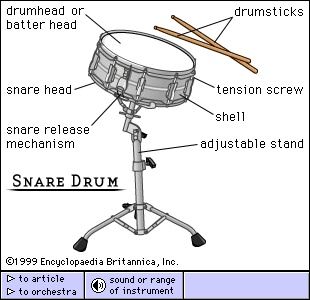snare drum
musical instrument
also called side drum,
 military and orchestral percussion instrument having several gut, nylon, wire, or wire-covered silk strings (snares) stretched across the lower, or snare, head; the snares vibrate sympathetically with the lower head (to which vibration is transmitted from the upper, or batter, head by air vibrations inside the drum), causing a snappy, penetrating, relatively high-pitched sound. The modern snare drum has a cylindrical shell of wood, plywood, or metal 5–12 inches (13–30 cm) high and 14–16 inches (35–40 cm) in diameter; deeper models, called field or guard's pattern drums, are used in many military bands. The heads, beaten with two tapered sticks ending in small knobs of wood or nylon, are of calfskin or plastic. They are held in place by a flesh hoop (around which the membrane is lapped) and a counterhoop. Membrane tensioning is by screws that act independently on each head, by metal rods, or, now chiefly in military bands, by rope lacings.
military and orchestral percussion instrument having several gut, nylon, wire, or wire-covered silk strings (snares) stretched across the lower, or snare, head; the snares vibrate sympathetically with the lower head (to which vibration is transmitted from the upper, or batter, head by air vibrations inside the drum), causing a snappy, penetrating, relatively high-pitched sound. The modern snare drum has a cylindrical shell of wood, plywood, or metal 5–12 inches (13–30 cm) high and 14–16 inches (35–40 cm) in diameter; deeper models, called field or guard's pattern drums, are used in many military bands. The heads, beaten with two tapered sticks ending in small knobs of wood or nylon, are of calfskin or plastic. They are held in place by a flesh hoop (around which the membrane is lapped) and a counterhoop. Membrane tensioning is by screws that act independently on each head, by metal rods, or, now chiefly in military bands, by rope lacings.Snares were known in ancient Egypt and occur on many modern Middle Eastern tambourines (tambourine). In medieval Europe they appeared on the upper head or sometimes both heads of the tabor drum. Large versions of the tabor developed into the side drum when two sticks, rather than one, were adopted and the snares were transferred to the lower head. It was suspended at the player's left side by a belt or a shoulder strap and was paired with the fife in Swiss infantry (lansquenet) regiments from the 14th century onward, subsequently spreading throughout Europe. The military role of the lansquenet's drum was crucial: it kept the marching pace and beat signals to action.
Early forms of the side drum were equal to or slightly greater in height than in diameter. They utilized thicker membranes and sticks than modern instruments, producing a heavier, less brilliant sound. The drum changed most drastically in the 19th century, becoming shallow, and often gaining a brass shell and rod or screw tensioning. Although since the early 17th century the tension of the snares could be controlled by a screw or lever, only in the 20th was a mechanism developed to release them instantaneously (for special effects or to avoid unwanted sympathetic vibrations caused by other instruments). Before the 20th century the membranes of snares were usually of gut.
Military playing of the snare drum was learned by rote and oral tradition into the 19th century, and only with the drum's eventual orchestral use did players need musical notation. Certain drummers in Basel, Switzerland, maintain a particularly difficult traditional playing technique. Modern compositions and jazz playing may require special effects, such as those obtained by releasing the snares, striking the rim, or using fingers, nonstandard sticks, or wire brushes. The first conclusively documented orchestral use of the snare drum was by the French composer–viol virtuoso Marin Marais (Marais, Marin) in a storm scene in his opera Alcyone (1706). It reappeared in Rossini's (Rossini, Gioachino) opera La gazza ladra (1817; The Thieving Magpie) with a solo part but did not become a standard orchestral instrument until its use by Nikolay Rimsky-Korsakov (Rimsky-Korsakov, Nikolay) and other Russian composers of the late 19th century. A concerto, the Geigy Festival Concerto for Basel drum and orchestra (1958), was written by the Swiss composer Rolf Liebermann.
- al- Muktafī
- al- Muqannaʿ
- al- Muqtafī
- al- Mustanṣir
- al- Mustaʿṣim
- al- Mutanabbī
- al- Mutawakkil
- Al- Muʿallaqāt
- al- Muʿizz
- al- Muʿtamid
- al- Muʿtaḍid
- al- Muʿtaṣim
- Al- Muḥarraq
- al- Muḥāsibī
- al- Māwardī
- Al- Nabaṭiyyah al-Taḥtā
- Al- Najaf
- Alness
- alnico
- Alnwick
- al- Nābighah al-Dhubyānī
- Al- Nāṣiriyyah
- Aloadae
- a lo divino
- Aloe